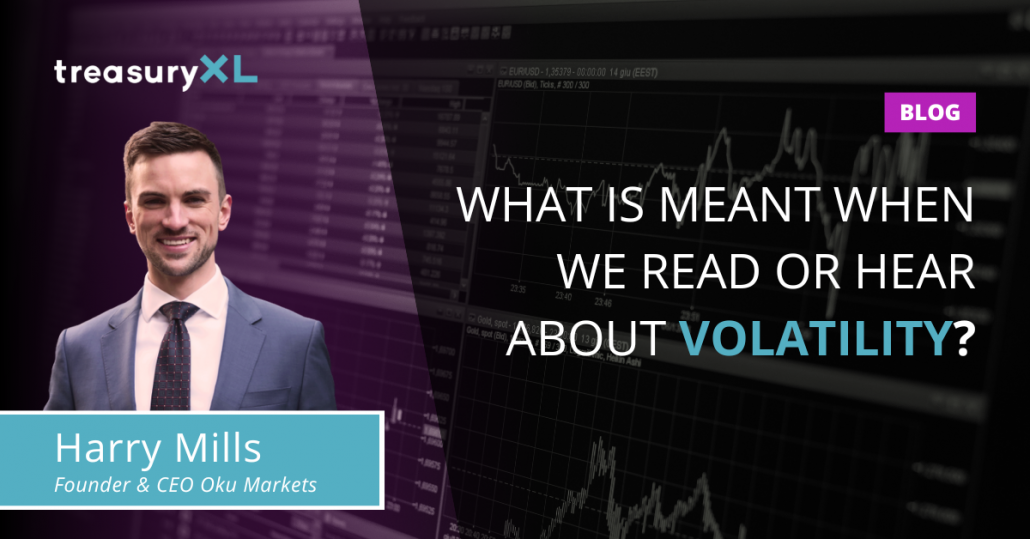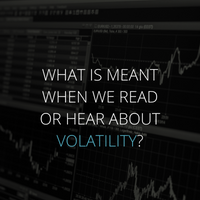What is meant when we read or hear about Volatility?
09-11-2022 | Harry Mills | treasuryXL | LinkedIn
We all have an intuitive feel for what volatility is – we know when a market is exhibiting high or low volatility because we see differences in price changes. But it pays to be more precise with our language and to understand what is meant when we read or hear about volatility.
By Harry Mills

Defining Volatility
Let’s start with a more instinctual and accessible definition:
Volatility is the rate at which prices change from one day to the next. If some currencies or other financial assets routinely exhibit greater daily price changes than others, they are considered more volatile.
Harry Mills, Founder & CEO Oku Markets
In his preeminent book, Option Volatility & Pricing, Sheldon Natenberg refers to volatility as “a measure of the speed of the market,” which is a particularly useful reference point when we consider that volatility and directionality are two different things: an underlying’s price can slowly move in one direction over time with very low volatility, or perhaps it swings wildly from day to day, but over a year it’s not changed much.
Now we have a feel for what volatility is, how do we quantify it? This third definition explains what it actually is: the annualised standard deviation of returns, and Natenberg refers to volatility as “just a trader’s term for standard deviation.”
This isn’t an article on standard deviation per se, but if you’re unaware of what this means then it is a measure of the dispersion of data around the average. Take for example if we measure the height of 1,000 people:
- If all 1,000 people are exactly 5’7″ then standard deviation is zero
- If standard deviation is two inches, then we know that 68.2% of people will be between 5’5″ and 5’9″ (see the normal distribution chart below)

What about “annualised” and “returns”?
Volatility is always expressed as an annualised number – this uniformity means that everybody knows what is meant when we talk about volatility being X%. In that sense, it’s rather like interest rates, which are also always described as an annualised figure.
This might not be so immediately useful to a trader or a risk manager, though, who might be thinking of daily or weekly price movements and where their risk or opportunities lie. Volatility is proportional to the square root of time, so to convert annualised volatility into daily, we simply divide the volatility by the square root of the number of days in a year – but we need trading days – on average there are 252, equating to 21 trading days a month. The square root of 252 is 15.87, but most traders approximate this to 16…
Hence, if we have a contract trading at 100 with a standard deviation of 20%, then: 20%/16 = 1.25%. We would therefore expect to see a price change of 1.25% or less for every two days out of three (+/- 1 standard deviation is around 68%).
Returns… I won’t go into detail, but if you want to explore this I would recommend chapter 10.6, The Behaviour of Financial Prices, in Lawrence Glitz’s superb Handbook of Financial Engineering which explains how price returns follow a normal distribution and prices follow a lognormal distribution. I’ll also add that calculating the standard deviation of prices doesn’t provide meaningful information because what we are looking for is the change from one period to the next, so we need to look at the daily returns!
Still here? Ok… let’s take it down a notch and look at the types and uses of volatility
Types of Volatility
There are a few types of volatility that can be measured, but by far the most commonly used and referred to are historical and implied volatility:
- Historical volatility is a backward-looking measure that shows how volatile an asset has been over say, a 20-day period. It’s useful to look at different time periods and to chart the daily movement in the volatility.
- Implied volatility is the future expected volatility – the term ‘implied’ is helpful because it literally means the volatility that is implied by the premium of an option contract. It’s a critical factor that influences options prices and draws the attention of traders and risk managers.
Uses of Volatility as an Indicator
Volatility is a common measure of risk, and it is a key component of Value at Risk modelling. But be warned of the ubiquitous disclaimer that past performance is no guarantee of future results.
Historical volatility is useful to understand how an asset or a currency has performed in the past – you can line this up with significant macroeconomic events and understand why there may have been a period of change, and you can get a feel for how the underlying “normally” behaves. For example, trading in the Turkish lira will probably present a higher risk than in, say the Swiss franc.
Summary
- Volatility is the rate at which prices change from one day to the next
- It demonstrates the “speed of the market” and is different from directionality
- Technically, volatility is the annualised standard deviation of returns
- You can approximate daily volatility by dividing the annualised volatility by 16
- Historical volatility tells us what happened in the past
- Implied volatility is the expectation of future volatility, and critical to option pricing
Thanks for reading!

Harry Mills, Founder at Oku Markets





